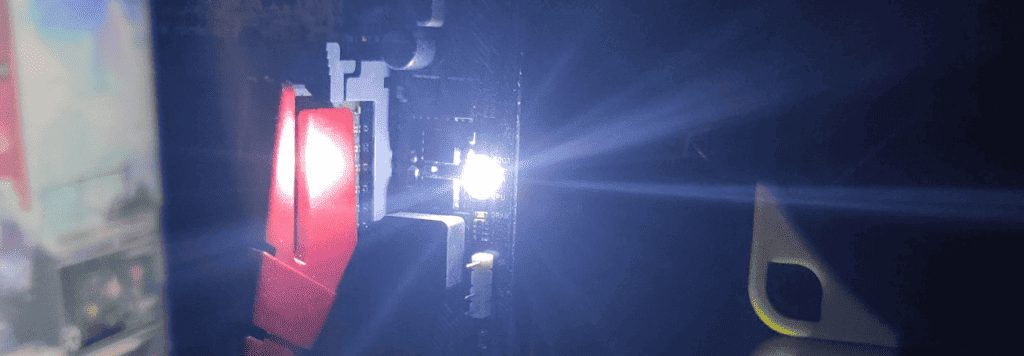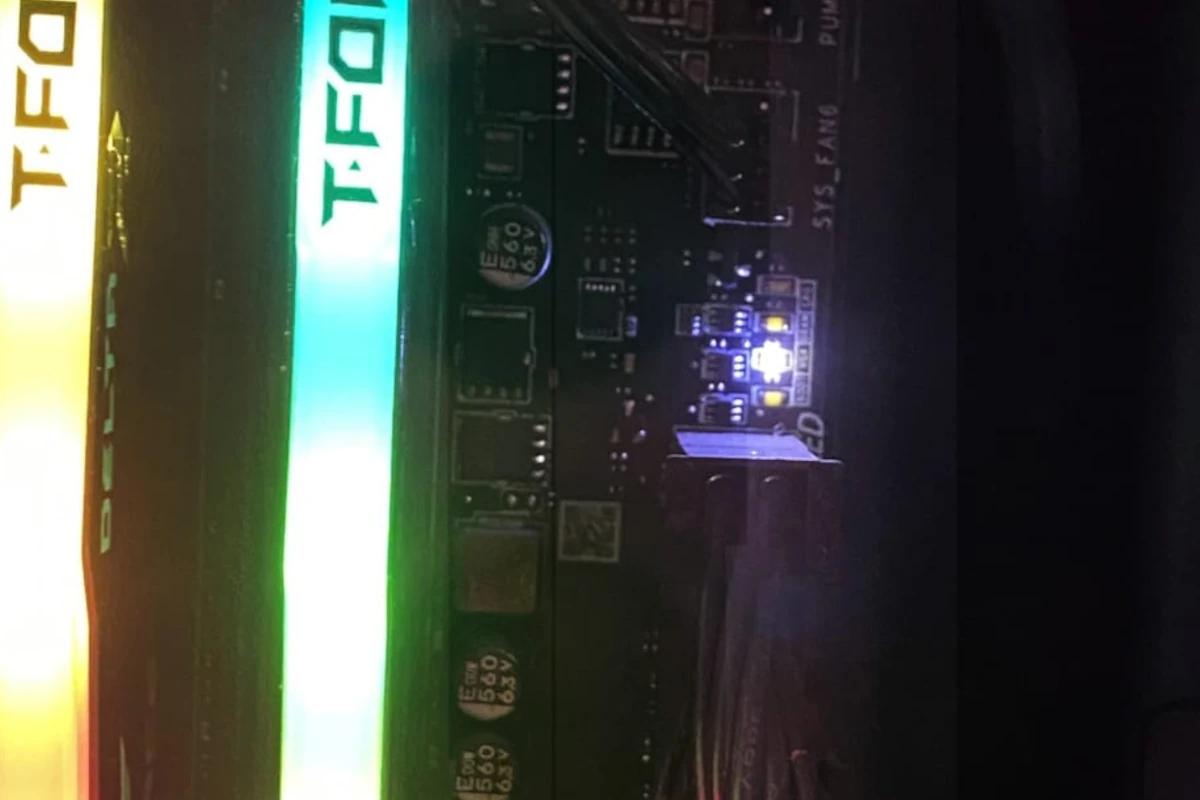If your computer is not displaying anything on the monitor and the VGA light is on, there’s potentially something wrong with the hardware (or setup) that your motherboard has detected. This light is a critical indicator that suggests a problem with the connection between the graphics card and the motherboard or the graphics card itself.
To fix this problem, you should take a systematic approach and diagnose the exact cause of the no-display issue. Start by verifying the physical connections and components by checking if the graphics card is seated correctly in the PCIe slot or if the RAM is installed correctly. Sometimes, this easy fix can solve the issue. If these steps do not work, you may need to test different components to pinpoint and replace faulty hardware. If you are unable to troubleshoot the issue on your own, it’s best to consult a professional to resolve the problem.

Troubleshooting Steps for ‘Motherboard VGA Light ON and No Display’
If your computer is turning on, but you’re seeing a VGA light illuminated on your motherboard and no picture on screen, it’s a sign something isn’t quite right with your graphics card or its connection. Don’t panic! Let’s troubleshoot this step-by-step.
What Does the VGA Light Mean?
The VGA light on your motherboard specifically monitors your graphics card. When it stays on after booting the computer, it usually indicates that the motherboard can’t detect your graphics card or there’s an issue preventing it from functioning properly.
Common Causes and Solutions
Here’s a breakdown of the most common culprits and how to tackle them:
| Issue | Potential Solutions |
|---|---|
| Graphics Card Not Seated Properly | * Power down the computer and open the case. * Gently remove the graphics card. * Carefully reinsert it into the PCIe slot, ensuring it clicks firmly in place. * Close the case and reboot. |
| Loose or Faulty Cables | * Check the power cables connecting your graphics card to the power supply. Ensure they are fully inserted.* Verify that your monitor’s cable is firmly connected to the graphics card (not the motherboard’s display ports). * Try a different cable or monitor if possible. |
| Corrupted Graphics Card Drivers | * If you were updating drivers before the problem, try booting in Safe Mode, then roll back or uninstall the new drivers. |
| Damaged Graphics Card | * If possible, test your graphics card in a different computer. * If it still doesn’t work, it might be faulty and need replacing. |
| BIOS or UEFI Issues | * Update your motherboard’s BIOS/UEFI to the latest version if one is available. * Check BIOS/UEFI settings to ensure the correct graphics source is selected (PCIe, not integrated graphics). |
Before Going Deeper
- Check your power supply: Is it powerful enough to support your graphics card? Underpowered systems can lead to this VGA light issue.
- Inspect components: Look for any visible signs of physical damage on your graphics card, motherboard, and connectors.
Additional tips
- Remove and reinstall the graphics card. Sometimes simple reseating can fix unexpected connection issues.
- Check motherboard manuals. Reference your motherboard’s manual for specific troubleshooting steps and the exact meaning of the VGA indicator light.
Key Takeaways
- The VGA light on a motherboard indicates a potential issue with the graphics card connection or failure.
- Methodical troubleshooting can often resolve the no display issue without seeking professional help.
- If personal efforts fail, consult a professional to avoid further damage and resolve the problem efficiently.
Diagnosing VGA Light Issues
When a computer shows no display and a VGA light on the motherboard is on, it indicates a potential issue with the video output. Understanding the light indicators, how they differ across motherboard brands, and the common causes can help pinpoint the problem.
Understanding VGA Light Indicators
The VGA light on a motherboard is a diagnostic LED that lights up when the motherboard can’t detect a graphics card or can’t communicate with it effectively. If the light stays on, this is a sign that something’s not right with the video output from the computer to the monitor.
Interpreting the VGA LED on Different Motherboards
Each motherboard manufacturer like MSI or ASUS has its own system for LED indicators. For example, an MSI motherboard may show a solid white or red light, while ASUS might have a blinking light. Checking the manual for specific LED status codes is helpful.
Common Causes for VGA Light Activation
Several issues can trigger the VGA light. Common causes include loose or incorrect placement of the graphics card in the PCIe slot, incompatible hardware, issues with RAM, CPU, or power supply. Sometimes even a depleted CMOS battery can cause problems. Checking these components for proper installation and compatibility should be the first step in troubleshooting.
Resolving No Display Issues
When a computer shows no display and a VGA light is on, it points to an issue with the video output. This section outlines clear steps for tackling such problems, keeping in mind a range of components from connections to system updates.
Physical Inspection and Reconnection
First, ensure that all components are properly seated. Power down the system and unplug it. Open the case and use a gentle touch to check for loose connections. The graphics card should sit securely in the PCIe slot. If anything is loose, reseat it firmly but with care. Sometimes dust builds up and causes trouble. Clean with compressed air and wipe off any dust on the contacts with a cotton swab dipped in rubbing alcohol. Reconnect and test for a display.
Updating BIOS and Drivers
Outdated BIOS or drivers might be the culprit, but if you’re not getting a video output you could be out of luck. Try installing an alternate video card to see if that gets you up and running. If so and the system boots, update the BIOS by downloading the latest version from the motherboard’s manufacturer website. Follow their instructions carefully. Next, check for the latest graphics card drivers for the card that is giving you problems. You can get tools to help you with drivers updates but the best bet is to visit the NVIDIA or AMD website to download whatever versions are the latest.
Update Motherboard BIOS: Check for a possible BIOS update from your motherboard manufacturer. Updated BIOS versions can sometimes resolve compatibility issues.
Clear CMOS: If recent changes to your computer’s hardware setup might be a cause, try clearing your CMOS (consult your motherboard manual for instructions).
Hardware Troubleshooting and Replacement
If problems continue, test the PC components. Use a known good video card to see if the display works. Swap the memory stick (DRAM) into different slots or try spare ones. Ensure the CPU fan is working as overheating can prevent booting. Check the PSU and its wattage; it must be powerful enough for all the PC’s parts. If none of this brings the display back, seek a professional for potentially damaged parts or deeper compatibility issues.
Frequently Asked Questions
This section provides solutions for common issues related to the VGA light on motherboards. Refer here for steps to troubleshoot, diagnose, and resolve situations when you have a VGA light but no display.
What steps can one take to troubleshoot a motherboard that displays a VGA light but no video signal?
First ensure the power supply is active and functioning. Then check that all hardware is properly connected. If issues persist, remove hardware one by one to isolate the source of the problem.
How can I determine if a VGA light indicates an issue with the motherboard or the graphics card?
If the VGA light remains on after you test the GPU in a different system and it works fine, the issue likely lies with the motherboard. Otherwise, the problem may be with the graphics card.
What actions should be taken when encountering a VGA light and no display after updating Windows 10?
One should check for driver updates for their GPU. If the issue remains, rolling back the update or restoring the system to a point before the update may resolve the problem.
How does one diagnose the cause of a VGA light being illuminated on an ASUS motherboard?
The user manual of ASUS motherboards lists what different lights mean. Pair this with disconnecting hardware and using onboard graphics to diagnose the issue.
Why would a VGA light be on even though the GPU appears to be functioning correctly?
This could point to a GPU not fully seated in the PCIe slot. Also, the power connectors must be firmly in place. Check these to ensure a proper connection.
Can a malfunctioning power supply result in a VGA light being turned on the motherboard?
Yes. An inconsistent or failing power supply may not provide the GPU with sufficient power, which can trigger the VGA light. It’s crucial to test the power supply or try a different one.







